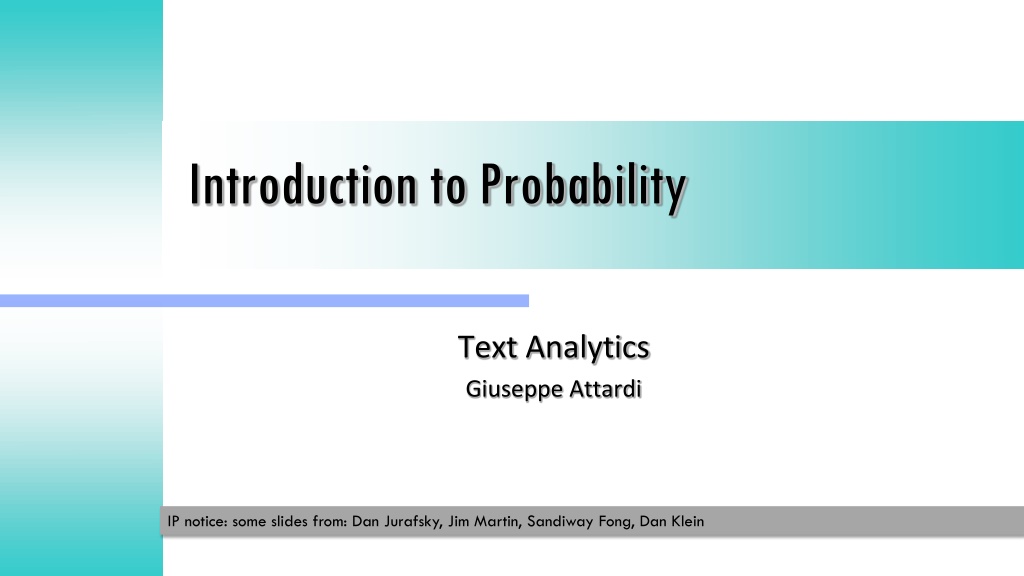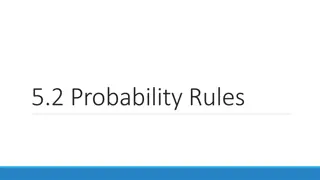Introduction to Probability: Key Concepts and Definitions
Explore the fundamental concepts of probability including basic probability, conditional probability, Bayes Theorem, independence, sample space, events, counting, and the definition of probability. Learn about the significance of sample space, event subsets, and how probability laws encode knowledge or beliefs. The material covers practical examples such as die toss experiments, drawing cards from a deck, and more, highlighting the essential principles of probability theory.
Download Presentation

Please find below an Image/Link to download the presentation.
The content on the website is provided AS IS for your information and personal use only. It may not be sold, licensed, or shared on other websites without obtaining consent from the author.If you encounter any issues during the download, it is possible that the publisher has removed the file from their server.
You are allowed to download the files provided on this website for personal or commercial use, subject to the condition that they are used lawfully. All files are the property of their respective owners.
The content on the website is provided AS IS for your information and personal use only. It may not be sold, licensed, or shared on other websites without obtaining consent from the author.
E N D
Presentation Transcript
Introduction to Probability Text Analytics Giuseppe Attardi IP notice: some slides from: Dan Jurafsky, Jim Martin, Sandiway Fong, Dan Klein
Outline Probability Basic probability Conditional probability Bayes Theorem Independence
Introduction to Probability Experiment (trial) Repeatable procedure with well-defined possible outcomes Sample Space (S) the set of all possible outcomes finite or infinite Example coin toss experiment possible outcomes: S = {heads, tails} Example die toss experiment possible outcomes: S = {1, 2, 3, 4, 5, 6} Slide from Sandiway Fong
Sample Space Definition of sample space depends on what we are asking Sample Space (S): the set of all possible outcomes Example die toss experiment for whether the number is even or odd possible outcomes: {even, odd} not {1, 2, 3, 4, 5, 6}
More definitions Events an event is any subset of outcomes from the sample space Example die toss experiment let A represent the event such that the outcome of the die toss experiment is divisible by 3 A = {3, 6} A is a subset of the sample space S= {1, 2, 3, 4, 5, 6} Example Draw a card from a deck suppose sample space S = {heart, spade, club, diamond} (four suits) let A represent the event of drawing a heart let B represent the event of drawing a red card A = {heart} B = {heart, diamond}
Counting Counting the Sample Space suppose operation oi can be performed in ni ways, then a sequence of k operations o1o2...ok can be performed in n1 n2 ... nk ways Example die toss experiment, 6 possible outcomes two dice are thrown at the same time number of sample points in sample space = 6 6 = 36
Definition of Probability The probability law assigns to an event E a nonnegative number Written P(E) Called the probability E That encodes our knowledge or belief about the overall likelihood of all the elements of A Probability must satisfy the Kolmogorov axioms
Kolmogorov Probability Axioms Non negativity P(A) 0, for every event A Additivity If A and B are two disjoint events, then the probability of their union (either one or the other occurs) satisfies: P(A B) = P(A) + P(B) Monotonicity P(A) P(B) for any A B Normalization The probability of the entire sample space S is equal to 1, i.e. P(S) = 1 A B =
An example An experiment involving a single coin toss There are two possible outcomes, H and T Sample space S is {H, T} If coin is fair, should assign equal probabilities to 2 outcomes Since they have to sum to 1 P({H,T}) = P({H}) + P({T}) = 1.0 P({H}) = 0.5 P({T}) = 0.5
Another example Experiment involving 3 coin tosses Outcome is a 3-long string of H or T S ={HHH, HHT, HTH, HTT, THH, THT, TTH, TTT} Assume each outcome is equiprobable Uniform distribution What is probability of the event that exactly 2 heads occur? E = {HHT, HTH, THH} P(E) = P({HHT}) + P({HTH}) + P({THH}) = 1/8 + 1/8 + 1/8 = 3/8
Probability definitions In summary: number of outcomes correspond ing to event E = ( ) P E total number of outcomes Probability of drawing a spade from 52 well-shuffled playing cards: 13 1 = = . 0 25 52 4
Probabilities of two events If two events A and B are independent i.e. P(B) is the same whether P(A) occurred or not then P(A and B) = P(A) P(B) Flip a fair coin twice What is the probability that they are both heads? Draw a card from a deck, then put it back, draw a card from the deck again What is the probability that both drawn cards are hearts?
How about non-uniform probabilities? A biased coin, twice as likely to come up tails as heads, is tossed twice What is the probability that at least one head occurs? Sample space = {hh, ht, th, tt} (h = heads, t = tails) Sample points/probability for the event: ht 1/3 x 2/3 = 2/9 th 2/3 x 1/3 = 2/9 Answer: 5/9 = 0.56 (sum of weights in red) = 1 - 4/9 (prob. of complement) hh 1/3 x 1/3= 1/9 tt 2/3 x 2/3 = 4/9
Computing Probabilities Direct counts (when outcomes are equally probable) A A P # # = ( ) S Sum of union of disjoint events P(A or B) = P(A) + P(B) Product of multiple independent events P(A and B) = P(A) P(B) Indirect probability: P(A) = 1 P(S A)
Moving toward language What s the probability of drawing a 2 from a deck of 52 cards with four 2s? P(drawingatwo) =4 52=1 13=.077 What s the probability of a random word (from a random dictionary page) being a verb? P(drawingaverb) =#ofwaystogetaverb allwords
Probability and part of speech tags What s the probability of a random word (from a random dictionary page) being a verb? P(drawingaverb) =#ofwaystogetaverb allwords How to compute each of these All words = just count all the words in the dictionary # of ways to get a verb: number of words which are verbs! If a dictionary has 50,000 entries, and 10,000 are verbs . P(V) is 10000/50000 = 1/5 = 0.20
Conditional Probability A way to reason about the outcome of an experiment based on partial information In a word guessing game the first letter for the word is a t . What is the likelihood that the second letter is an h ? How likely is it that a person has a disease given that a medical test was negative? A spot shows up on a radar screen. How likely is it that it corresponds to an aircraft? Or to a failure of the screen?
More precisely Given an experiment, a corresponding sample space S, and a probability law Suppose we know that the outcome is within some given event B We want to quantify the likelihood that the outcome also belongs to some other event given event A We need a new probability law that gives us the conditional probability of A given B P(A|B)
An intuition A is it s raining now P(A) in Tuscany is .01 B is it was raining ten minutes ago P(A|B) means what is the probability of it raining now if it was raining 10 minutes ago P(A|B) is probably way higher than P(A) Perhaps P(A|B) is 0.10 Intuition: The knowledge about B should change our estimate of the probability of A.
Conditional probability One of the following 30 items is chosen at random What is P(X), the probability that it is an X? What is P(X|red), the probability that it is an X given that it is red? O O O O O X X O O X X X O O X X O X O X O X O X X O O X O O
Conditional Probability Let A and B be events P(B|A) = the probability of event Boccurring given event Aoccurred definition:P(B|A) = P(A B) / P(A) S A B
Conditional Probability A ? ? ? =?(? ?) =?(?,?) ?(?) B A,B ?(?) Note: P(A,B) = P(B|A) P(A) also: P(A,B) = P(B,A) hence: P(B|A) P(A) = P(A|B) P(B) hence:
Bayes Theorem ? ? ? =? ? ? ?(?) ?(?) P(B): prior probability P(B|A): posterior probability
Independence What is P(A, B) if A and B are independent? P(A, B) = P(A) P(B)iffA, B independent P(heads, tails) = P(heads) P(tails) = 0.5 0.5 = 0.25 Note: P(A|B) = P(A)iff A, B independent Also: P(B|A) = P(B)iff A, B independent
Independent Events S = 100 A=25 15 B=60 Independence P(A) = P(A|B) 25/100 = 15/60 P(A B) = P(A) P(B) 15/100 = 25/100 60/100 Independence does not mean disjoint
Independence Revisited These four statements are equivalent: A and B are independent events P(A and B) = P(A) P(B) P(A|B) = P(A) P(B|A) = P(B) 1. 2. 3. 4.
Monty Hall Problem (Pacchi in Affari Tuoi, Italian TV) The contestant is shown three doors. Two of the doors have goats behind them and one has a car. The contestant chooses a door. Before opening the chosen door, Monty Hall opens a door that has a goat behind it. The contestant can then switch to the other unopened door, or stay with the original choice. Which is best?
Solution Consider the sample space, three doors: Car, A, B There are three options: 1.Contestant chooses Car. If she switches, she loses; if she stays, she wins 2.Contestant chooses A with goat. If she switches, she wins; otherwise she loses. 3.Contestant chooses B with goat. If she switches, she wins; otherwise she loses. Switching gives 2/3 chances of winning
Other Explanation P(choice = Car | Open) = 1/3 Opening door does not change P(other = Car | Open) = 2/3 P(choice = Car) = 1/3
Summary Probability Conditional Probability Independence
Additional Material http://onlinestatbook.com/chapter5/probability.html























